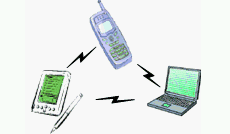
| |
|
|
Technical Links
IEEE 802.11 IEEE 802.15 Bluetooth.com Bluetooth.org ZigBee Wireless USB Short-Range Wireless |
Department
of Electrical
and
Computer Engineering
EECE 285 - Group Project
Spring 2005 - Section 201 - Group 21
Short Range Wireless Communications Systems
in Public Places: Opportunities and Implications
O. Kirby * N. Matni * N. Rilloma * R. Sandhu * N. Soofi * N. Silvanovich
Supervisor: Prof. Dave Michelson
EECE 285 - Group Project
Spring 2005 - Section 201 - Group 21
Short Range Wireless Communications Systems
in Public Places: Opportunities and Implications
O. Kirby * N. Matni * N. Rilloma * R. Sandhu * N. Soofi * N. Silvanovich
Supervisor: Prof. Dave Michelson
 |
EECE
285 students will work with UBC's Radio Science Lab, the Neil
Squire Foundation, and ICORD at Vancouver Hospital to determine how
best to
use and deploy short range wireless systems in the 10,000 square metre,
$46 million spinal cord research facility that ICORD will build in two
years. Issues
include: technologies, applications, coverage and reliability,
coexistence and security, and software and accessibility. |
PROJECT RATIONALE
| For many years,
researchers have predicted a trend towards an increasing number of
embedded computers connecting to surrounding devices and the Internet
through wireless links. Proponents of pervasive
(or ubiquitous)
computing
believe that it will revolutionize building automation, sustainability,
personal security, and access to information. For many years, the
concept of pervasive computing was an abstract one; the technologies
required to implement it were either too primitive or simply didn't
exist. In the past few years, however, many of the enabling
technologies have caught up. For example, the development of
standards for short-range wireless communications by IEEE 802 and other
industry groups will play an important role in making it possible to
realize pervasive computing environments. As ICORD prepares to build a 10,000 square metre, $46 million facility for spinal cord research at Vancouver Hospital, they believe that the time is right to conduct a pilot project concerning the use of wireless technologies in a major research building. The pilot project differs from earlier studies in that: (1) it considers the potential role of all the major short-range wireless standards that have been proposed or ratified, (2) it accounts for deployment issues such as coverage, reliability, and coexistence, and (3) it considers the role of pervasive computing in assisting the disabled. Given the scale of the project, the amount of money being spent, and the novelty of the issues, ICORD prefers not to treat this as a routine deployment of information technology. Instead, they want to carefully consider the long-term implications of deploying technology in certain manners in order to avoid making bad decisions that they will regret later on. |
REPORT OUTLINE AND
TASKS
This web document will be updated frequently throughout the course of the project.
This web document will be updated frequently throughout the course of the project.
| 1. Introduction |
Keywords: intelligent buildings, pervasive
computing, ubiquitous computing, assistive technology, accessibility,
IEEE 802
|
| Context and opportunity |
|
| Previous work and its limitations |
|
| Objectives and Approach |
|
| 2. Survey of Wireless Technologies |
Keywords: RFID, PAN, WLAN, UWB, WUSB, IEEE 802, ZigBee,
Bluetooth |
| RFID |
|
| Personal Area Networks |
Bluetooth
- IEEE 802.15.1 Wireless USB - IEEE 802.15.3 ZigBee - IEEE 802.15.4 |
| Wireless Local Area Networks |
IEEE 802.11 |
| Other |
|
| 3. Potential Applications of
Short-Range Wireless in Public Places |
Keywords: intelligent buildings, pervasive computing, ubiquitous computing, assistive technology, accessibility, IEEE 802, M2M |
| Network Access |
|
| Device Interconnect |
|
| Remote Control |
|
| Accessibility |
|
| SCADA |
|
| 4. Coverage and Reliability |
Keywords: path loss, shadowing |
| 5. Coexistence and Security |
Keywords: interference, throughput |
| 6.
Conclusions and Recommendations |
|
http://www.ece.ubc.ca/~prop/eece285/index.html
Last modified: 16 Jan 2005
Comments? Suggestions?
Please contact Dave Michelson, davem@ece.ubc.ca